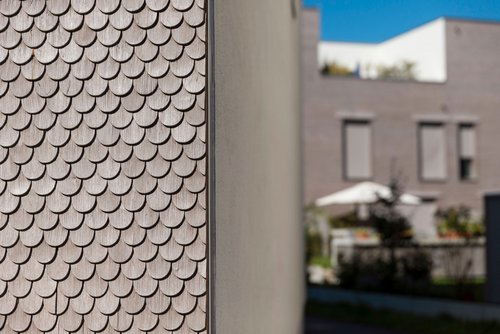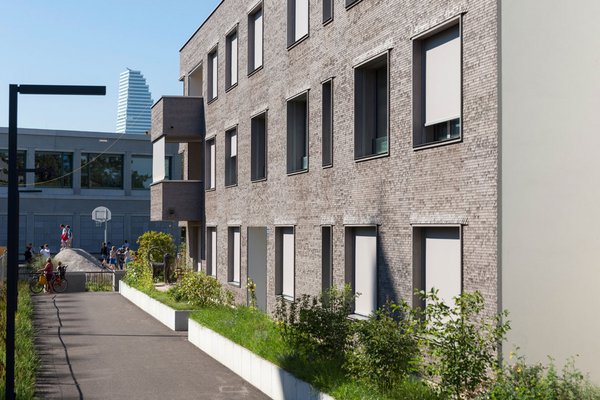
No 2000-watt buildings without wood
Without the use of timber buildings, the targets of the 2000-watt society would have been very difficult to implement," says Yves Deluz, Sustainability Project Manager at Implenia, underlining the importance of the renewable building material for Basel's "schorenstadt". At the time of development, the lighthouse project in terms of environmentally friendly urban development was the largest superstructure in Switzerland to date that not only meets the Minergie-P-Eco standard for minimum energy consumption in operation and for ecological construction. The "schorenstadt" also meets the much more comprehensive requirements for a 2000-watt society.
All factors taken into account
This concept, developed by ETH Zurich, states that in a long-term sustainable world, each person should not use more than 2000 watts of continuous power on average. In the building sector, the SIA Energy Efficiency Path specifies the target values for greenhouse gas emissions and the consumption of non-renewable primary energy that must be achieved in the three areas of construction, operation and mobility. The efficiency path takes into account all relevant factors, from the location to the construction method to the energy supply.
The difference is in the grey greenhouse gas emissions
In building practice, the achievement of the target value for greenhouse gas emissions is particularly critical. Among other things, this includes the so-called grey greenhouse gas emissions. These include the total amount of greenhouse gases generated by a product – in this case a building material – from the extraction of raw materials and their processing to transport and disposal.
In this respect, wood has a clear advantage over all other building materials, as Deluz explains. Not only is the energy input for its extraction and processing much lower. In fact, trees ensure a negative greenhouse gas balance during their development by binding CO2 from the ambient air during their growth. The bound CO2 is released again when it is recycled as fuel. But this step also generates usable energy and not just disposal costs. The bottom line is that timber construction causes between 15 and 30 percent less greenhouse gas emissions than all other construction methods.
High demand for ecologically convincing buildings
For a building owner, however, it is not only the ecological balance of a project that is decisive. The economic efficiency must be just as sustainable. Deluz identifies this point as the great unknown at the start of the "schorenstadt" project. The question was whether a buyer's market could be found for the property with its forward-looking ecological aspects. But even in this respect, "schorenstadt" exceeded the targets. By the time it was completed, 90 percent of the residential units had already been sold. Especially in urban areas, property buyers and tenants are obviously more and more willing to pay for an ecological plus.
Timely coordination with project management
According to Deluz, the fact that this ambitious pioneering project was able to achieve its goals on time and within budget is due in no small part to Implenia's comprehensive portfolio of expertise. The settlement was implemented by Implenia from development through planning to realisation. Both the timber construction and the conventional master builder work were carried out by Implenia, which enabled timely coordination and optimised the construction process. Another success factor was the excellent interaction with the sustainability department. "We are the specialist planners for sustainability within Implenia and can coordinate quickly with the construction departments if necessary," explains Deluz. This was all the more important because the "schorenstadt" was breaking new ground in many of the implementation details and Deluz therefore had frequent exchanges with the project and construction managers.
Mr Brönnimann, you were one of the first families to move in at the end of 2014. How is life in the "schorenstadt"?
Exceptionally good! The "schorenstadt" is like a village community in the city. On summer evenings, when the shingle facade shimmers in hundreds of different colours, we often sit together with neighbours and our daughter is practically at home in the whole residential street.
Why did you and your wife choose "schorenstadt"?
The decisive factor for us was the sustainable overall concept. At the time, we had several properties to choose from. The "schorenstadt" was the only project that was both ecologically and socially well thought out. It was important to us that our daughter grows up in an environment worth living in. And we are not the only ones. The vast majority of residents consciously opted for the "schorenstadt" concept.
How does timber construction affect living comfort?
Compared to the late-1980s flat we lived in before, the indoor climate is strikingly better. Even when the windows are closed, the air is always fresh and the wood also brings its characteristic, pleasant smell. In addition, despite the strictest ecological criteria, we do not have to do without the comforts of modern living.




